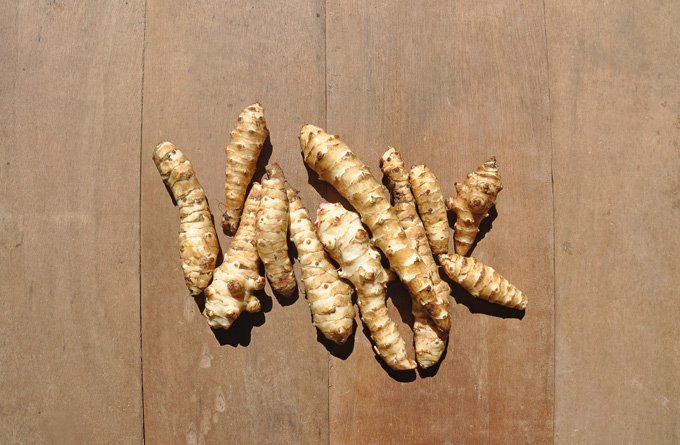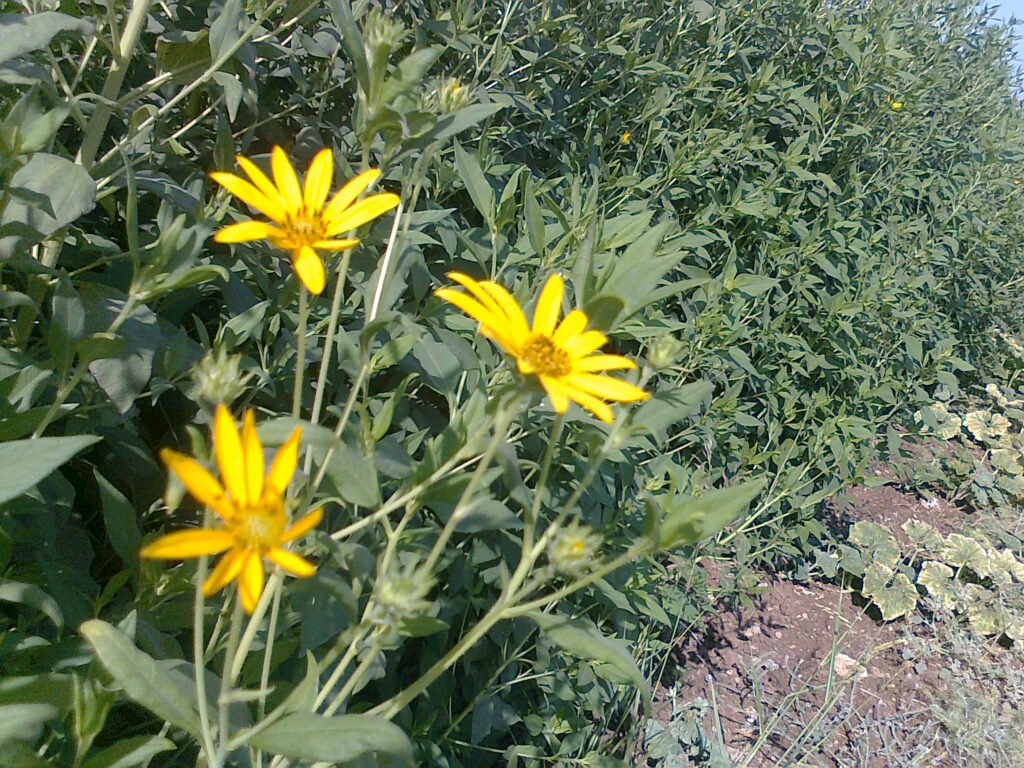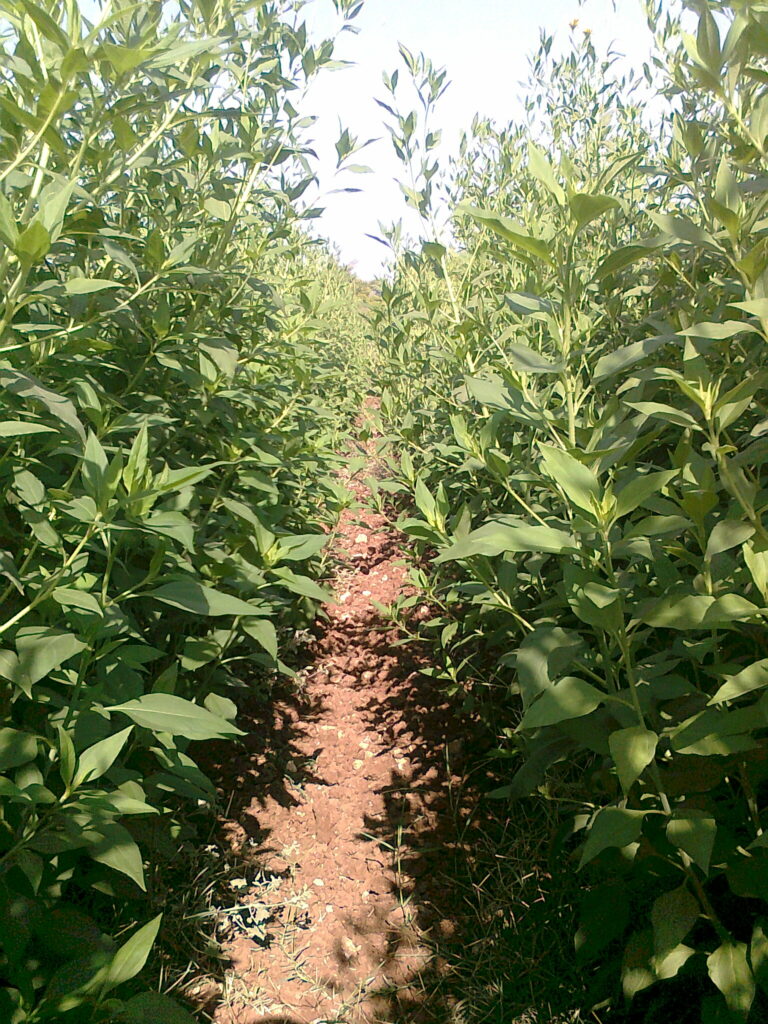Our field is completely wintery. A stroll among the vegetable beds reveals the many farewells we’ve bade over the past month to last of the summer veggies. Their dry plots in their final days have been transformed to rows of tiny sprouts, young plants and green mature plants infused with power from the winter crops now commanding the field.
But at the center of our field, one last jungle-like plot remains. Its tall tangled plants, most bent by the recent strong winds and showers, are a faded green with dry yellow flowers, and its longer leaves bear a brown hue. But don’t be fooled –just below it, the vibrant world of the underground is bursting with life – thickening, filling out, ripening, and for the past weeks sneaking into (most of your) boxes on a weekly basis. And I suddenly realized that we forgot to give them their well-earned respect this year!
I hope by now you’ve all figured out that although it looks like ginger, it is certainly not ginger!
Introducing the star of this week’s Newsletter, the incredible sunroot, aka Helianthus tuberosus, or better yet the very confusing moniker Jerusalem Artichoke.
This great photo from Gal’s blog, Ptitim
We waited for them over six months, till the bushes dried up and wilted. Only then could we chop those down and begin extracting the secret treasures buried beneath – delectable, satiating bulbs that will enhance every soup, quiche, antipasti or salad. And you don’t need a lot — just a touch adds a phenomenal seasoning to any dish.
Here at Chubeza, sunroots are one of our newer products. After an experimental crop five years ago, we were pleased with the outcome. Actually, more than pleased. And ever since, they have been steady and delicious autumn-to-winter tenants.
In America, they’re commonly known as “sunchokes,” but actually the title “sunroot” is an accurate description, for the Jerusalem artichoke is in fact a species of sunflower which develops an edible root bulb. The origins of this delectable bulb are in the North American East Coast from Georgia to Nova Scotia, where it has been both growing wild and cultivated in Native American vegetable gardens for years on end. The bulb fully enjoys the American sunshine and rich, fertile earth, yielding farmers and gleaners its rich roots abounding with energy and sweetness.
The Europeans, who came to visit and stayed to conquer, tasted the sunroot and loved it. First to describe the bulb was French explorer Samuel de Champlain, who noticed it in a Cape Cod vegetable garden in 1602. He sent some sunroots to France, from where they meandered to England, Germany and Italy in the 17th century. The Italians termed it girasole, Italian for “sunflower.” Somehow the pronunciation was distorted to “Jerusalem,” and it stuck. The “artichoke” part came from the fact that it somewhat resembles the artichoke in taste.
Like any sunflower, the sunroot adores the sun and thrives during the summer. For Chubeza, this is the fifth summer we’ve watched its growth. I say “watch,” because from the moment we placed the bulbs in the earth until we plunged the pitchfork in to extract them, we really did not have much to do (aside from occasional weeding and watering). We were rather amazed at the beautiful strength of its growth, at its ability to joyfully grow wild and dare the weeds to even think of coming close. Thankfully, in our field the Jerusalem artichoke is free from pests (moles and rats are their natural nemesis), which is why we could just step aside and simply watch it grow. Patiently.
Here it is going wild, blooming, growing. The Jerusalem artichoke in Chubeza:
And yes, it required much patience. The plant took its sweet time for at least seven months, growing, wilting and clandestinely swelling up its unique roots below. Only at the beginning of October when the foliage had dried up did we insert the pitchfork to examine the situation, just to discover that we needed more patience. So we waited a bit longer, regularly sampling some to gobble up for lunch. Now, several weeks later, we are finally beginning to pull out all these yummy, distinctive bulbs, with hope they stay with us through February.
Though it grows underground like the potato (even if it is more stubborn and recalcitrant than the spud) and has a similar caloric value, the Jerusalem artichoke is low in carbs. Instead of starch, it contains inulin, a fruit sucrose carbohydrate, soluble in water (which is how it stores its energy in the root bulb). Inulin aids in lowering blood sugar levels, making it recommended for diabetics (contrary to potatoes!). Inulin feeds the friendly microbes in the intestines and reduces the threat of a variety of diseases. These bulbs are an excellent source of thiamine (B1), iron, niacin, Vitamin B3 and potassium. Chinese medicine classifies the Jerusalem artichoke as a warming vegetable which strengthens the digestive system. A great winter vegetable!
Tips:
Jerusalem artichokes must be refrigerated, preferably in a closed plastic bag or sealed plastic container, to prevent them from growing soft.
Conventionally, the Jerusalem artichoke is eaten peeled, which can be a tiresome task to prepare. But, you don’t actually have to peel off the skin. You can certainly scrape it off, cook or bake it unpeeled. You may also steam the bulbs for several minutes to greatly ease the peeling procedure.
The Jerusalem artichoke turns black quickly after being peeled, so it is recommended to place it in a bowl filled with water and lemon juice.
And what about the bulby elephant in the newsletter? In this case, the gas issues (making this wonder veggie known in America as “fartichokes”). The gas is created from the breakdown of the inulin, the fruit sucrose as mentioned above. So if it makes you gassy, start by consuming small quantities. Two additional gas-reducers: cook the sunroots separately, drain, and then add to your dish; or cook/bake them seasoned with cumin which assists digestion and reduces gas.
Check our recipe section for a variety of ideas for cooking and serving the amazing sunroot, but feel free to add it to other familiar and favorite recipes in your own creative way. It truly enhances the flavor in nearly every dish. Bon appetite!
Wishing everyone a good and healthy week,
Alon, Bat Ami, Dror, Yochai, Orin and the entire Chubeza team
_________________
WHAT’S IN THIS WEEK’S BOXES?
Monday: Swiss chard/totsoi/New Zealand spinach/kale, turnips/baby radishes, Jerusalem artichokes/potatoes, cucumbers, tomatoes, broccoli/peas, carrots, parsley/dill/coriander, lettuce/mizuna/arugula, cabbage/cauliflower. Small boxes only: scallions/leeks.
Large box, in addition: Kohlrabi/fennel/daikon, beets, onions, celery/celeriac.
FRUIT BOXES: Pomela, bananas oranges, kiwi.
Wednesday: Swiss chard/totsoi/New Zealand spinach/kale, turnips/baby radishes, Jerusalem artichokes/potatoes/peas, cucumbers, tomatoes, broccoli/cabbage, carrots, parsley/coriander, lettuce/mizuna/arugula, scallions/leeks/onions, celery/celeriac.
Large box, in addition: Kohlrabi/fennel/daikon, beets, cauliflower.
FRUIT BOXES: Pomela/pomelit, bananas/avocado, oranges, kiwi.



